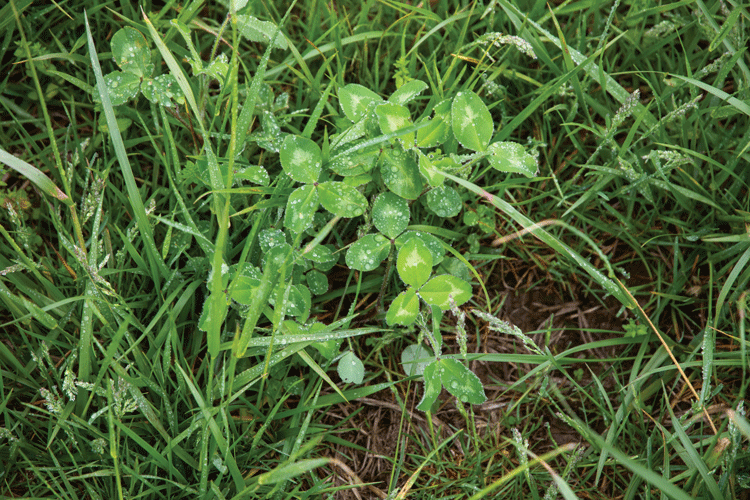Time for interseeding |
| By Jim Gerrish |
|
|
|
The author is a rancher, author, speaker, and consultant with over 40 years of experience in grazing management research, outreach, and practice. He has lived and grazed livestock in hot, humid Missouri and cold, dry Idaho.  The Year of the Great Inflation is how many people will remember 2022. Among the numerous things that inflated in 2022 was the price of nitrogen fertilizer. It seems every time the nitrogen price goes up, there is a surge of interest in interseeding legumes in pastures and hayfields. Should times of high fertilizer prices be the only time we think about legumes as a nitrogen source for our pastures? My experience has been that nitrogen fertilizer hasn’t been economically competitive with legumes in a pasture for at least 40 years. I have already made this point in this column a few years ago. In the 23 years we were on our farm in Missouri, there were only three occasions that we ever used nitrogen fertilizer on a pasture. We are approaching 19 years on the ranch in Idaho, and it has been nine years since any kind of fertilizer has been applied to these pastures. The only time nitrogen has been applied had been as a tag-along with phosphorus being applied as 11-52-0 every three or four years. Always a benefit Whether fertilizer is expensive or not, it makes sense to grow legumes in your pastures wherever and whenever it is feasible. A mixed grass-legume pasture provides better balanced nutrition than either a grass or a legume monoculture. Numerous studies have shown superior animal performance with mixtures compared to monocultures. Aboveground plant diversity increases belowground biodiversity to the benefit of soil health. Many pollinators enjoy legume blooms. Oh, and there is the nitrogen-fixation benefit as well. Since most pastures around the country are deficient in legume content, it is time to think about how and when to interseed them to gain all those benefits. We have a few options that we have found to be successful in different environments. Frost seeding is a broadcast seeding method that works well for most small-seeded legumes in regions that have regular freeze-thaw cycles in late winter or early spring. There is often concern about seed-soil contact with this method. If a pasture has been stockpiled for winter grazing and then is strip-grazed, seed-soil contact is usually adequate. If a pasture has all of its fall residual left intact, then dragging the pasture can help get seed down to the soil. Reliable spring moisture is also a necessity. That can either be as natural precipitation or through irrigation. In an irrigated environment, it is important to make sure to keep the newly seeded area moist. We have seen many overseedings germinate on the natural moisture but then wilt when irrigation is not begun in timely manner. Go with late snow Another broadcast method that we have had good success with is seeding on top of a late snow. We don’t like seeding over the long winter snow cover. That type of snow often melts off the top, and broadcast seed can be washed away with snow melt water flowing across the crusted snow or ice sheet below. Once the winter snow cover has melted off and the ground has thawed somewhat, that’s when it’s time to be ready for your spring legume overseeding. When you get a new snow cover, get out there and start broadcasting seed. One big advantage of broadcast seeding in this situation is that you can actually see your wheel tracks and do a more uniform seeding job. The darker legume seed absorbs heat and “burrows” down into the snow. Most of these later snows melt from the bottom up. In the process, the melt water typically infiltrates and doesn’t run off. The seed can literally be sucked into the soil surface. There are some situations where a no-till drill actually makes more sense than broadcast seeding. We generally budget broadcast seeding at $4 to $6 per acre while no-till drilling may range from about $15 to $28 per acre. That is a big cost difference for getting your seed out there, but there are some legumes that establish more consistently when drilled compared to broadcast seeded. Those legumes needing special seeding attention in many environments include both alfalfa and birdsfoot trefoil. I have seeded both of those legumes successfully by the broadcast method but less consistently than most clovers have established over the years. We also find a no-till drill to be more consistent for irrigated pastures with very low natural rainfall. In this situation, we generally plan to drill the seed within a few days of beginning irrigation. This works very well with any sprinkler system. Broadcast seeding often performs poorly on flood-irrigated ground as seed may wash away with the first surge of flood water. Legumes are valuable components in almost every pasture situation. In a good part of the U.S., late winter and spring is the seeding season. Get your seed early and get it in the ground in timely manner. This article appeared in the March 2023 issue of Hay & Forage Grower on page 12. Not a subscriber? Click to get the print magazine. |
